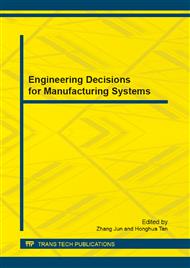p.25
p.32
p.40
p.44
p.50
p.56
p.62
p.67
p.72
Monitoring the EDM Characteristics of Ti-6Al-4V Process Stable Using Individual Moving Range Control Chart
Abstract:
This study deals with the optimization of the process parameters, with regard to multiple performance characteristics, involved in the electrical discharge machining (EDM) of titanium alloy (Ti6Al4V).Based on the grey-Taguchi method were conducted to examine the effect of EDM parameters (pulse current, open voltage, pulse-on-time, and duty factor) on the electrode wear rate, material removal rate and surface roughness. Experimental results indicate that optimal process parameters can be determined effectively so as to improve multiple EDM qualities through this approach. Furthermore, control charts tell us when special causes of variation are impacting machining process. Control charts are basic and powerful tools in statistical process control and are widely used to control various industrial processes. The aim of statistical process control is to explore the predictability of a process. It was found that the EDM process and product characteristics are stable over time.
Info:
Periodical:
Pages:
50-55
Citation:
Online since:
September 2013
Authors:
Price:
Сopyright:
© 2013 Trans Tech Publications Ltd. All Rights Reserved
Share:
Citation:


